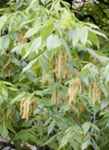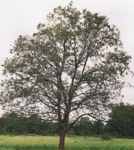HICKORY
HICKORY
(Plant heights are given at maturity)
 Mockernut
Hickory (White hickory) Carya tomentosa
- Deciduous tree with
grey
ridged bark and slightly hairy twigs native to the eastern half of the
US. The trees produce thick shelled edible nuts that are an
excellent wildlife food. Hardy to -30F (-34.4C); height:
60ft.
Mockernut
Hickory (White hickory) Carya tomentosa
- Deciduous tree with
grey
ridged bark and slightly hairy twigs native to the eastern half of the
US. The trees produce thick shelled edible nuts that are an
excellent wildlife food. Hardy to -30F (-34.4C); height:
60ft.
| #1718 Packet $5.50
Approximately 15 seeds |
|
 Shagbark Hickory
- Carya ovata - Tall, fast growing tree having large pinnate
leaves and
bearing delicious nuts. The hard grey-brown bark peels in strips
and the shells of the fruits are thinner than the shellbark
type.
Does well in almost any soil. Hardy to -30F (-34.4C);
height:
100ft.
Shagbark Hickory
- Carya ovata - Tall, fast growing tree having large pinnate
leaves and
bearing delicious nuts. The hard grey-brown bark peels in strips
and the shells of the fruits are thinner than the shellbark
type.
Does well in almost any soil. Hardy to -30F (-34.4C);
height:
100ft.
| #930 Packet $5.50
Approximately 15 seeds |
|
| #P930 18-24inch tree
$24.95
|
|
| #P3-930 (18-24inch trees)
Three trees for $33.99 |
|
Shellbark Hickory (Kingnut Hickory) - Carya
laciniosa - The
fruits
of this variety are longer and have an excellent flavor, but the shells
are a bit harder than the Shagbark. Pretty in the
spring when it
blooms. Grows quickly. Hardy to -30F (-34.4C); height:
100ft.
| #931 Packet $5.50,
Approximately 15 seeds |
|
| #P931 2-3ft. tree
$34.95 |
|
| #P4-931 (2-3ft.
trees) Four trees for $50.95 |
|
 Water Hickory
- Carya aquatica - Deciduous tree with light brown ridged
bark native
to
the southeastern US, found usually around creeks or streams.
Produces
small edible hard shelled nuts. Good for wildlife food.
Hardy
to -20F (-28.8C); height: 60ft.
Water Hickory
- Carya aquatica - Deciduous tree with light brown ridged
bark native
to
the southeastern US, found usually around creeks or streams.
Produces
small edible hard shelled nuts. Good for wildlife food.
Hardy
to -20F (-28.8C); height: 60ft.
| #1712 Packet $6.50
Approximately 15 seeds |
|
TIP: SEED SCARIFICATION
The
seed coat of some seeds are tough and must be penetrated by
scarification involving the breaking, scratching or
softening of the
seed coat to allow moisture to penetrate. Natural scarification
occurs as the seed is exposed to freezing and thawing temperatures or
microbial activities that modify the seed coat during the winter.
Scarification can also occur as seeds pass through the digestive tract
of birds or other animals and can also naturally occur by fire.
Natural scarification is what we aim to achieve
by fall planting. Some hard seeds can take more than one year to emerge
naturally, and achieve low propagation rates naturally. Methods of
artificial scarification include: MECHANICAL, HOT
WATER, and ACID.
|
ORDER EARLY!
See TERMS
Back to VARIETY INDEX Terms
HOME
 If
you have arrived in someone else's frame, or can not see all of the
other
information available on richfarmgarden.com Click on logo to enter from
beginning
If
you have arrived in someone else's frame, or can not see all of the
other
information available on richfarmgarden.com Click on logo to enter from
beginning
 Mockernut
Hickory (White hickory) Carya tomentosa
- Deciduous tree with
grey
ridged bark and slightly hairy twigs native to the eastern half of the
US. The trees produce thick shelled edible nuts that are an
excellent wildlife food. Hardy to -30F (-34.4C); height:
60ft.
Mockernut
Hickory (White hickory) Carya tomentosa
- Deciduous tree with
grey
ridged bark and slightly hairy twigs native to the eastern half of the
US. The trees produce thick shelled edible nuts that are an
excellent wildlife food. Hardy to -30F (-34.4C); height:
60ft.
 Shagbark Hickory
- Carya ovata - Tall, fast growing tree having large pinnate
leaves and
bearing delicious nuts. The hard grey-brown bark peels in strips
and the shells of the fruits are thinner than the shellbark
type.
Does well in almost any soil. Hardy to -30F (-34.4C);
height:
100ft.
Shagbark Hickory
- Carya ovata - Tall, fast growing tree having large pinnate
leaves and
bearing delicious nuts. The hard grey-brown bark peels in strips
and the shells of the fruits are thinner than the shellbark
type.
Does well in almost any soil. Hardy to -30F (-34.4C);
height:
100ft.
 Water Hickory
- Carya aquatica - Deciduous tree with light brown ridged
bark native
to
the southeastern US, found usually around creeks or streams.
Produces
small edible hard shelled nuts. Good for wildlife food.
Hardy
to -20F (-28.8C); height: 60ft.
Water Hickory
- Carya aquatica - Deciduous tree with light brown ridged
bark native
to
the southeastern US, found usually around creeks or streams.
Produces
small edible hard shelled nuts. Good for wildlife food.
Hardy
to -20F (-28.8C); height: 60ft.